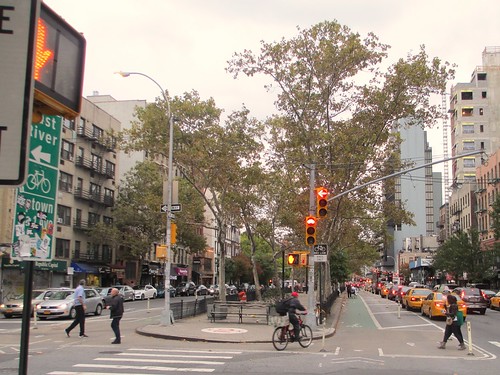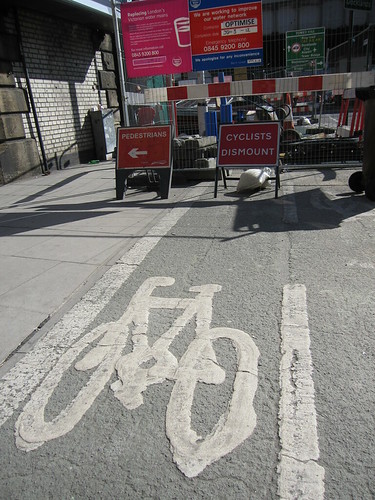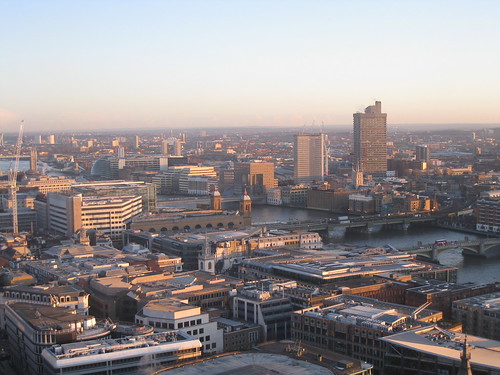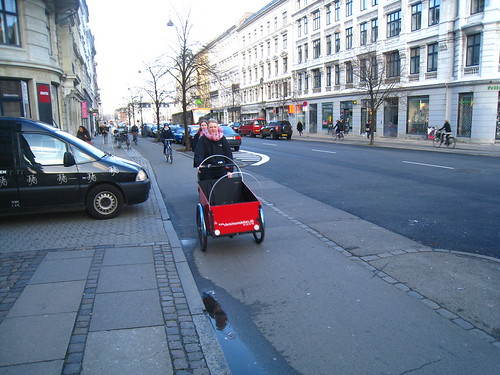It was far from being the most dignified manoeuvre I’ve ever
made on a bicycle. Around 9.25am on January 29, as I rode to work down Prince
St in lower Manhattan ,
I heard a garbage truck approaching me from behind, its driver blaring the horn. Since the
bike lane was still full of snow and I was in the middle of the street’s single
travel lane, I was immediately in the vehicle’s path – and fearful the driver
wouldn’t stop before hitting me. I pulled over into a clear patch of the bike
lane, jammed on my brakes and apologised to the cyclist following me for
pulling across her path. The garbage truck careered past.
 |
| A bike on Vandam Street, SoHo, testifies to my fellow cyclists' enthusiasm for tackling New York streets in the snow |
The next morning, chastened by my experience and with fresh,
light snow falling, I decided to mix with motor vehicles as little as
practicable, to ride over the Brooklyn Bridge , through TriBeCa
and up the Hudson River Greenway, which had been well cleared of snow the night
before. But, when I pulled onto the Greenway, I found there had been no new
treatment following the light overnight snow. I rode very gingerly uptown,
worrying that the layer of slushy slow would cause my tyres to lose their grip.
The two experiences encapsulated the challenge that even I,
a fairly hardy cycle commuter, face when trying to get around a city by bicycle,
especially in winter. I need a network of viable routes I can follow to get
places. I’m more likely than many people to regard a route that includes
jostling with motorists or that isn’t marked as a bike route “viable”. Yet people
unused to city cycling or in areas with poor infrastructure probably spend most
of the time feeling the way I do when there’s snow and ice about. It’s as if
the subway offered a choice of only highly circuitous routes or routes that
stop every few blocks and required one to walk.
The realisation explains a fundamental disconnect I’ve
noticed in perceptions of New York ’s
efforts to boost cycling. I regularly hear from cyclists in other places –
particularly London – who’ve seen pictures of New York ’s flagship
cycle infrastructure projects and been impressed with the city’s apparent
commitment to boost cycling. Few accept my reply that, since only 1 per cent of
commuter trips in New York are by bicycle, the efforts are at least
partially failing. “At least it’s better than we’ve got here,” they tend to
reply, gazing longingly at pictures of the Prospect Park West bike lane or Allen St .
Still fewer correspondents contacting me from London accept my follow-up
point. Although London currently lacks many showpiece,
well-designed facilities to match the best in New York ,
I point out, 4 per cent of commuting trips in London are by bicycle. There is clearly some
aspect of cycling policy in London – bedevilled as it has been by a lack of boldness and a reliance on dubiously effective road
markings – that has proved vastly more successful than New York ’s approach. The question is what’s
making the difference.
The answers, of course, don’t lie entirely in road layout. London has, for example, the Central London congestion
charge, which over the last 12 years has sharply cut the numbers of vehicles
entering Central London daily. Thanks partly
to Sheldon Silver – the recently-disgraced former speaker of the New York state senate – New York
lacks such a mechanism to keep through traffic out of lower Manhattan .
Public transport in London is
also far more expensive than in New
York , making a switch to cycling far more attractive financially.
Yet one of the biggest parts of the answer, I’d suggest, can
be found in thinking about the fate of the Boeing 747. The jumbo jet, hugely
successful though it has been, faces phasing out at least partly because it was designed for an
era when airlines sought consistently to operate “hub-and-spoke” services,
feeding traffic from around a given region into a hub. Passengers would be
transferred at those hubs onto long-haul flights on airlines’ hyper-efficient
747s.
 |
| The Allen St bike lanes: enjoy the view, wistful Londoners - but be sceptical this picture tells the whole story |
Instead of a network, New
York has built a series of sections of bike lane,
with noisy objections to the loss of parking or some other complexity keeping
the sections all too often separate from each other. The regular changes in
colour of the routes on the city’s bike map – indicating a change from a
protected lane to a painted lane, to mere “sharrows” then back – are testament
to New York officials’ weakness in the face of noisy, local protest. Perhaps
the emblematic failure relates to the Hudson River Greenway. It’s one of the
safest, most comfortable to use bike facilities in the city. But nearly every
means of accessing it south of 59th
St involves a suicidally dangerous manoeuvre amid
lines of fast-moving cars seeking to reach the West Side Highway.
It’s little surprise that, presented with confusing routes
that disappear in the most dangerous places, relatively few New Yorkers are taking up
the invitation to start cycling.
When I lived in London ,
by contrast, my head was full of the routes – often complex and roundabout,
admittedly – of the London Cycle Network. The LCN – now out of fashion, since
its introduction was overseen by Ken Livingstone, the former mayor - follows
routes mainly along back streets across the city. It is so comprehensive that,
by the time I left London ,
I could do 30-mile round trips on it without consulting a map. London ’s existing Cycle Superhighways –
appallingly designed as most are – at least seek to provide routes that take people
to places. Both reflect what seems to me a greater tendency on the part of London ’s planners than New York ’s to think in terms of routes, not
isolated projects.
This week’s decision by Transport for London ,
the London
mayor’s transport body, to go ahead with a comprehensive network of segregated bike paths should make the position far, far better. Unlike New York ’s rather disjointed system, they
should act more and more like the most efficient networks – like metro systems
that draw commuters in from distant suburbs into heavily-used, highly-efficient
core areas or express parcel networks. Such networks’ strength is their
comprehensiveness – well-planned new metro lines generate disproportionately
high numbers of journeys because they unlock new point-to-point journeys both
on the existing network and the new line. London ’s
networks, at least in theory, aim to provide a reasonably consistent journey for
a high proportion of the trips in the city that are possible by bicycle.
 |
| A London cycle path: an example of the "infrastructure" that made me once doubt infrastructure was the answer |
Not, of course, that the simple dichotomies are the whole
story. London ’s cycle planners are, I know,
prone to some of the same shortcomings as those in New York . I so despaired when I lived in
London of the dire quality of much of the existing cycle infrastructure that I
preferred an approach that sought to make onroad cycling safer. The roundabout,
backstreet routes I often used are so circuitous that many simply won’t use
them. In thousands of rides past South London ’s
busy Elephant & Castle interchange, I took one of the avoiding routes off
the main roads every single time. To many other people, that route is so
painfully slow that they prefer the main roads, where there are regular deaths.
Nevertheless, New York
currently risks, it seems to me, watching from the sidelines as London ’s new network of
protected routes turns the city’s existing provision into a still more
successful network. It’s hard to imagine New York’s achieving anywhere close to
its target of having 6 per cent of trips by bikes by 2020 until it starts
taking the challenges of providing a real network seriously.
Ms Trottenberg may be about to start
tackling the issue in earnest, even if her department's record of retreat on markings for "slow zones" suggests otherwise. But the history of the Bleecker St – Broadway-Lafayette
station on the New York City
subway is a stark reminder that such changes don’t happen on their own in this
city. The city’s IND
subway network built Broadway-Lafayette station in 1936 immediately under Bleecker St station
of the Interborough Rapid Transit Corporation. In 1940, the city subsequently took over
the IRT and its rival BMT subway, forming them with the IND into an allegedly unified
system enjoying the benefits of being a single network. Yet it was only in June
2012, after I arrived in New York ,
that a full connection between the two stations – which had sat immediately
adjacent to each other for 76 years – was finally opened.
If New York





Great blog, but can you please disable smart tags? They don't display in RSS clients and serve no purpose since IE6. Things quickly get unreadable without place names. See example from my feed:
ReplyDelete’s streets are, in addition, far safer than ’s, even if that’s damning with faint praise. For 2013, the last full year for which figures are available, there were 294 road fatalities in , which has a slightly lower population than , including 168 pedestrians and 10 cyclists. In in the same year, there were 132 road deaths in total, including 65 pedestrians and 14 cyclists. ’s far higher cycling rates make it clear that it’s a far safer place to ride per mile travelled than .
Anonymous,
DeleteThanks for the comment. We're going to run up against my technical limitations here, however. I can't find anywhere in the Blogger software where smart tags are enabled, so I can't work out how to disable them. This might, I suggest, reflect the shortcomings of Blogger, which I suspect is a project Google periodically hands to an intern to play with. There are multiple bugs.
If any reader knows how to disable smart tags, though, I'll turn those babies off in a second.
All the best,
Invisible.
I wonder if there are major differences between the facilities provided by business in London and NY as I think availability of showers and somewhere to store your bike will make a difference if deciding to commute by bike or not.
ReplyDeleteAnecdotally, the company I work for in London has put bike racks on almost all its car parking spaces in an underground car park and set aside a small room for lockers and drying facilities and there are showers as well. The underground car park is shared by the building tenants and most other companies have put bike racks on their car parking spaces as well.
I've been considering moving jobs and cycle facilities is one of the questions I would ask a new employer. Without exception, all of the other 3 companies I've spoken to provide similar facilities to my current employer.
These are all companies employing a few hundred people in central London and the situation is likely to be different for smaller businesses.
Anonymous,
DeleteIt's a reasonable point - but this is actually something where New York is in reasonable shape. There's a law requiring employers to seek an exemption from the city if they want to ban bicycles from their building. It has been effective in ensuring that pretty much all employers have some kind of indoor bike storage facility. I'm definitely noticing the difference in the condition of my bike from London, where I had to store my bike in an outdoor bike shed, which had a roof but was nothing like protected from the elements.
My building doesn't have showers and that may be a deterrent for many people, especially in the city's appallingly humid summers. But bike storage provision is mostly OK.
All the best,
Invisible.
It might be helpful to focus at this time on neighborhood cycling as well as on crosstown trips. In Phoenix where I live, the neighborhood cycling is fairly good, given quiet side streets, adequate bike lanes, and some canal paths. Within three miles of my house, I can easily cycle to twenty restaurants, ten grocery stores, ten coffee shops, some bakeries, and so on, and see many others starting to take up the neighborhood cycling practice instead of driving. In New York, with its much higher density and neighborhood variety, and a tradition of walking, neighborhood cycling may seem less attractive--in many neighborhoods, if you walk a mile, you can find a bewildering variety of everything you might want to eat or buy, or get on easy public transport to take you there. But back to where I live, the crosstown cycling network is still a shambles, with lack of connectivity, exposure to high speed vehicle traffic, and all the rest you mention. I keep hoping neighborhood cycling is the gateway to better crosstown cycling, though, as increasing numbers in the former may lead to more demand for the latter.
ReplyDeleteJRA,
DeleteThank you as ever for the thoughtful comment.
There is some neighbourhood cycling in New York but, as you mention, the city's density means that most people, at least in the inner bits of the city, can walk to pretty much all their amenities. Further out, cars dominate and people simply drive. I guess the key question here is whether demand for cycling facilities leads to their construction. The connection I mention between Broadway-Lafayette and Bleecker St would have been useful from day one and provides an exceptionally useful link in the New York City transit network. It took 72 years after subway unification for it to be built.
All the best,
Invisible.
With respect, your info about the 747 is wrong. Mind boggling numbers of reasons available upon request, but basically a 777-300ER carries as much as a 747-400 with lower costs, while now having the range and ETOPS capability to go almost all the same places. A far better analogy would be the "hub and spoke" transfer approaches of most transit systems.
ReplyDeleteSteve,
DeleteI guess you've caught me in a slightly inept analogy only because I'd written recently about the looming demise of the 747. I know you know whereof you speak when it comes to aerospace matters.
But I'm a fair man. I've checked the seating capacity of a 777-300ER and a 747-400 and you're right they're pretty much the same, so I've changed the wording.
I guess my main points are, firstly, to say: look, I've just been writing about 747s and this seems to me a tiny bit maybe slightly similar. Secondly, I'm saying: this is a slightly more exciting way of saying networks are important and people want them to provide smooth connections rather than the disconnections New York's cycle facilities currently provide. Transit systems are an analogy for it, as you see at the end. Container shipping networks are another - and indeed shipping lines have increased the number of point-to-point services in recent years.
I hope the new wording does less casual violence to the actual, you know, facts. Thank you, as ever, for your insights.
All the best,
Invisible.
Irony is that Boeing backed off launching the 747-600 in 1996 because of marginal economics in an ever more point-to-point world, but launched ten years later after Airbus had a competitor in place to shrink that market further. I guess the lesson is: "don't be second to market with a concept whose time is passing." What WERE they thinking?
ReplyDeleteBoeing has made a generally impressive job of competing in many parts of the long-haul jet market. But it has been determined to keep the 747 going at a time when it's really not clear it has much of a future.
DeleteIt is interesting to read your comparison of cycling infrastructure provision in London and New York.
ReplyDeleteI commute on a daily basis in the former, but my experience of the latter is limited to one evening's ride around Lower Manhattan (principally the waterfront, though I did ride through Times Square, which was interesting!) on a Brompton, during a trip across the Atlantic.
Unfortunately, too many routes in London are at the mercy of borough councils that are biased towards the motor-centric status quo. Westminster, and Kensington & Chelsea are particular bad in this respect, the latter effectively acting as a 'dog in the manger' blocking safe, segregated cycle routes joining up with the Mayor's new facilities for areas further west such as Hammersmith & Fulham and Hounslow. See, for example, the following: http://www.getwestlondon.co.uk/news/local-news/cyclists-blame-lack-cycle-route-7901260
Does New York have similar issues with borough authorities (rather than local NIMBYs) who refuse to cooperate and hence implement the necessary joined-up networks?
Anonymous,
DeleteI'm aware of the problems with certain boroughs in London - but it's easy to underestimate how much London benefits from having a city-wide organisation like TfL driving at least aspects of the strategy. I know it won't feel like this to people who cycle regularly in Westminster or Kensington & Chelsea but there is at least an overall strategy.
The problem in New York is that there are local bodies called Community Boards that get a say over local planning and they are full of the very last people one should have running such a thing. They're obsessed with maintaining parking spaces, pathologically suspicious of change and utterly uninterested in wider strategy. The Department of Transportation is allowed to ignore them - but in practice it doesn't do so very much. That's what prevents the construction of a decent network, as far as I can tell.
All the best,
Invisible.
At least the boroughs are democratically elected so will do things if they see there are votes in it, although I can't see a change in administration in K&C or Westminster anytime soon!
DeleteAs someone who commutes through K&C, I think it is going to be a long game to get them to do something. Once the new East-West route goes in and hopefully is a huge success, and assuming Hammersmith and Fulham get their act together, then the glaring gap in the middle through K&C may shame even them to do something about it because of the increased numbers cycling through.
Michael
DeleteI'm probably a little out of date on the details of what's happening in London, although I do remember it was pretty easy at certain borough boundaries to tell the difference in approach. I hope Kensington & Chelsea comes to its senses - but it's clearly not easy to be particularly optimistic.
As for the New York City community boards, they're a huge problem. I'm no fan of Tony Benn, but his questions to people in power reveal the problems with these bodies:
What power do you have?
Where did you get it?
In whose interests do you exercise it?
To whom are you accountable?
How can we get rid of you?
None of the answers to those questions is particularly satisfactory when it comes to community boards.
All the best,
Invisible.
Robert,
ReplyDeleteI was on the Hudson River Greenway on the same day as your photo above (it looks familiar), and almost every other weekday this winter. To be honest, it was not so bad down there. It's been consistently much worse north of 59th St, and especially north of 72nd. If you do venture that far north, you can forget about riding the bike up most of the ramps to street level. Pretty much every last one of them has significant chunks of snow mounds and ice sheets. South of 59th St, on the other hand, where the Hudson River Park trust takes responsibility for clearing the snow, has consistently been the easiest and safest part of my trip on snowy days. I would not want what you wrote to encourage anyone to ride inland streets instead.
Best,
Tal
Tal,
DeleteYou're not the first person to suggest I was over-reacting to conditions on the Greenway that day. My defence would be that I think it got worse quickly over a few hours that morning. I was there around 9.30am, which I think was probably about as bad as it got, as it started snowing around 7.30am and stopped around the time I was there.
But there's also the fact I'm a physical coward with a high centre of gravity who gets skittish about slippery conditions.
I rode north of 59th St once last winter in the snow and I know what you mean about the change - I immediately hit a patch of frozen snow after crossing 59th St. The issue, I think, is that the Greenway is a state park south of 59th St and a city park north of it. The city parks department sadly doesn't care about critical transport infrastructure such as the Greenway.
All the best,
Invisible.
"Don't you realize society built everything for you? All the roads, all the streets, the parks, the stores, the parks, the libraries, the banks ...they were all built for you."
ReplyDeleteOf course the actual reality is that anything one uses or anywhere one goes is primarily by default.
You access whatever is most convenient and/or whatever is most available in whatever city/town/area you live. Whether they be supermarkets, banks, restaurants, highways, streets...
Societies never build anything "for their citizens". They build and create things primarily for themselves. To create a persona, for egotistic purposes.
Societies build and create things mainly to "demonstrate their mettle" ("Hey, look what WE'RE capable of!")
Nothing in any city, town, or community is ever exactly "custom-made" for any one individual. We're forced to use whatever's available, and to improvise and juryrig as is necessary to fit our own individual needs and desires the best we can.
Tal,
DeleteThanks for the comment.
It's true that societies build things as statements about themselves. That, I suppose, is at the heart of why so many not-very-cycle-friendly places are rushing to introduce bike-hire schemes - they have a certain cachet.
I'm not saying, however, that I should have a custom-designed route to take me from Carroll Gardens to my office in the Hudson Square area of the West Village/SoHo. My point is that there are big flows of people on bikes from areas like mine and like Park Slope towards the East River bridges and there could be more if the routes were better. There are also large numbers of people - and potentially far more - seeking to ride from the East River bridges to areas such as Hudson Square, Chelsea and midtown and it's scandalous that the network caters so poorly to these people. I'm currently using the Brooklyn Bridge most days, for example. The Manhattan end of the bridge bike path spills cyclists into two lanes of hectic traffic and forces them to pull into the middle of the road to make the most useful turns. To introduce something better at that location wouldn't be to ask for some custom-designed route - it would be a simple way of making life better for thousands of cyclists a day.
All the best,
Invisible.
In NYC, as with anywhere else, one's always "at the mercy of" whatever society, the merchants, the church, and the charities decide to create and build, as they will always be "the only choices" for said city's/town's/community's citizens, residences, and visitors.
DeleteTal,
DeleteWell, I naively hope we can do a little better than that.
Invisible.